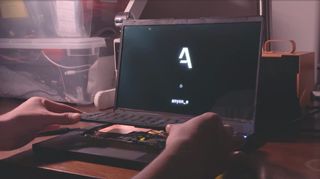Student builds open-source laptop in 6 months — uses 4K AMOLED screen and has 7h battery life
This student project is even better than some entry-level laptops.

Byran Huang, a senior high school student from the Phillips Exeter Academy, built a fully open-source laptop as his fall term senior project, and it took him just six months to finish it. He called it anyon_e and it features a 4K AMOLED display, a Cherry MX mechanical keyboard, and around seven hours of battery life. According to Huang, he wanted to build a laptop “that hits as many qualities of a modern commercial thin & light laptop—while trying to do as much from scratch as possible.”
He used a Raspberry Pi alternative, the Rockchip RK3588 SoC, which he says is the “fastest consumer-procurable chip on the market”, built into the FriendlyElec CM3588 system-on-a-module with 16GB of LPDDR4X memory. The specifications for the SoC included a quad-core Cortex-A76 and a quad-core Cortex-A55 CPU, a Mali-G10 GPU, and an NPU that outputs 6TOPS. It could also push out 8K video at 60FPS, plus its I/O ports include an 8K display, dual USB3.1, PCIe 3.0 x4, and HDMI 2.1/eDP 1.4. We wonder if the upcoming Raspberry Pi Compute Module 5 16GB will find itself in a similar build?
For the display, Byran used a 13.3-inch 4K Samsung AMOLED ATNA33TP11 display that’s also found on several Asus laptops. Although it may seem like this screen is plug-and-play, Huang soon found out that it was difficult to drive a 4K display over eDP 1.4 because of signal integrity issues. After a few tests and calculations, he discovered that shortening the length between the CPU and display solved it, which finally allowed his screen to work.
The laptop’s keyboard was built using Cherry MX ULP mechanical switches on a separate removable case that can be used as a separate wireless keyboard. But despite this functionality (which meant the keyboard required its own 200mAh battery and SoC), he was able to maintain a height of under 7mm to keep it nice and compact. As for the mouse, anyon_e is equipped with the Azoteq PXM0057-401 glass surface and multi-touch trackpad that worked over USB; and it only cost Huang $35.

Aside from these things, he also acquired several parts like the batteries from AA Portable Power Corp. in California, and screen hinges from the Framework Laptop 13. He also used Joshua Riek’s ubuntu-rockchip kernel/distro, which made it a lot easier to have a working operating system on the anyon_e because of its great out-of-the-box experience and optimizations. However, Byran still had to build some things from scratch himself. This included the laptop’s mainboard and its CNC aluminum chassis, plus a few small 3D printed plastic structural parts to give the laptop stability.
In the end, Byran was able to create a sleek and polished laptop that could compare against other flagship devices created by Asus and Apple that cost several thousand dollars. The anyon_e laptop could even boot three seconds faster than Huang’s own MacBook Pro, which is already a tightly integrated device. And since this is an open-source project, the laptop is not hiding any secrets underneath—anyone with the knowhow, equipment, and grit to follow his process could recreate the anyon_e.
Stay On the Cutting Edge: Get the Tom's Hardware Newsletter
Get Tom's Hardware's best news and in-depth reviews, straight to your inbox.

Jowi Morales is a tech enthusiast with years of experience working in the industry. He’s been writing with several tech publications since 2021, where he’s been interested in tech hardware and consumer electronics.
-
ezst036 Its criminal that all these parts aren't standardized and freely-ready off the shelf with numerous different laptop-intended motherboard, laptop case, laptop power supply, and laptop monitor options.Reply -
stonecarver Brian Huang if you ever bump into this thread on Tom's just want to say great job. :)Reply
